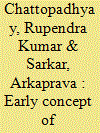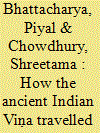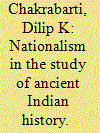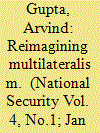| Srl | Item |
| 1 |
ID:
186228


|
|
|
| 2 |
ID:
186231


|
|
|
|
|
| Summary/Abstract |
Indian music before the 10th century AD was of a kind which we may today even find
difficult to understand, because we are no longer familiar with the nuances of that
tradition. The original forms of the musical instruments used during that time have
also virtually disappeared from mainstream India. But these instruments can be found
more or less in their original form outside India in South East Asia. These instruments
travelled out of India to these countries due to historical reasons. This essay brings
forth research that help us reconstruct the journey of the ancient Indian string
instruments (the Harp, the Tube Zither and the Stick Zither) from their original form
to their highly developed modern form, and in that process, demonstrates how India
was the fountainhead of foundational theories upon which classical string instruments
have developed in various cultures outside India, especially Myanmar and Cambodia.
|
|
|
|
|
|
|
|
|
|
|
|
|
|
|
|
| 3 |
ID:
186230


|
|
|
|
|
| Summary/Abstract |
The historiography of ancient India has been an ideological battleground since the
very beginning. The histories of ancient India written during the colonial period by
Europeans were heterogenous in nature. On the one hand, there were works with clear
imperialist imprint such as the ones by E J Rapson, and on the other hand, we have
the pioneering works of Vincent Smith, which are not as imperialist as they are made
out to be. The works of nationalist historians such as R K Mukherji, R C Majumdar, U
N Ghoshal and others were mainly in response to works like those of Rapson. These
pioneering historians of the late 19th and the first half of the 20th century have been
characterized as “Hindu revivalists” by a section of later Indian historians who mostly
belong to the Communist fold. The purpose of the present paper is to put this accusation
in the context of the history of research on ancient Indian history and archaeology
and judge if this is at all true or merely a communist propaganda and ploy to build up
a ‘progressive’ versus ‘obscurantist’ divide among the historians of ancient India. The
paper will also examine how certain currents of thought in modern Indian archaeology
pose a danger to Indian security.
|
|
|
|
|
|
|
|
|
|
|
|
|
|
|
|
| 4 |
ID:
186232


|
|
|
|
|
| Summary/Abstract |
A major challenge in understanding the past is that it is not available for exploration
at present. The sections of history that deal with geographical associates of human
endeavours also pose a challenge to the readers and learners about the scale and
experience of a past landscape. Despite the cognitive and reasoning capabilities of
individuals, views of an entire landscape cannot be achieved by normal eye view.
Geospatial technologies provide immense potential for accessing historical landscape
and past realities. The tools are helpful in twin ways. Firstly, they enable learners to
understand the existing information about landscape by providing synoptic and 3D
views through interactive visualisation tools. Secondly, they enable researchers to look
for clues to the past settlements in a landscape in ways that are not otherwise possible,
i.e. “see” through infrared lens and integrate evidence gained from observations made
across different times. The present paper discusses some of these advantages that we
gain by applying gospatial technologies to normal human perceptions.
|
|
|
|
|
|
|
|
|
|
|
|
|
|
|
|
| 5 |
ID:
186229


|
|
|
| 6 |
ID:
186227


|
|
|